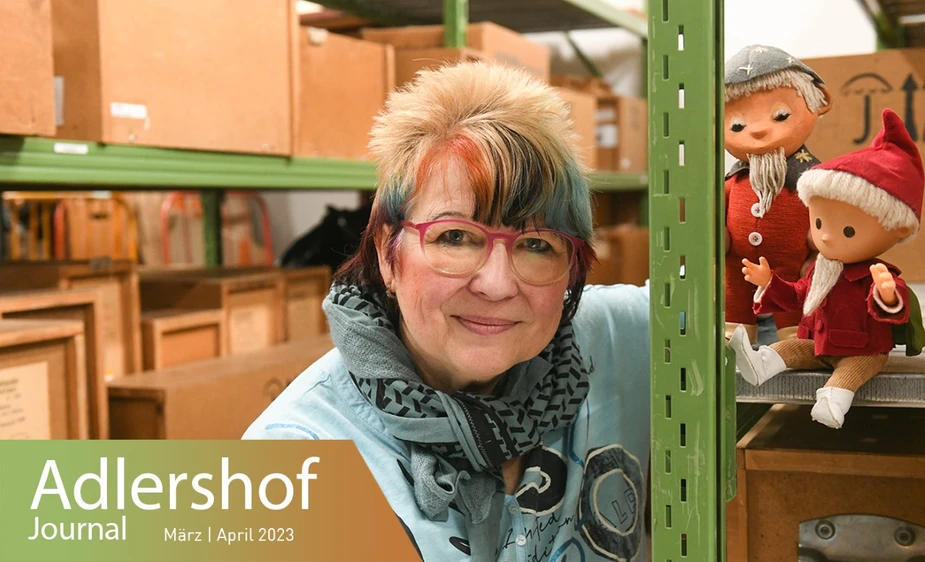A box full of memories
Sabine Berger was an animator on GDR television. An exhibition at Theater Ost commemorates the start of broadcasting
Guten Abend, verehrte Fernsehfreunde – good evening, dear TV fans – were the fairly unspectacular words that launched the first two-hour broadcasts of German television in the former Soviet occupation zone, uttered by host Margit Schaumäker on 21 December 1951 at 8 pm, three days before the West. Around 70 East German television sets were able to receive them, all of them in Berlin. Across several wall charts, the exhibition “On the Air! – The first German television in Berlin Adlershof” at Theater Ost tells the story of the beginning of TV broadcasting 70 years ago.
It was curated and designed by Claudia Opitz and Sebastian Köpcke. The educational wall charts in the theatre’s foyer look at the first stages of television. Hanna Janowitz-Christian, the first camerawomen in the world in 1952, is also honoured with a panel. Throughout her career, her official job title was “cameraman”.
In 1954, children’s television was born. Five years later, Gerhard Behrendt designed “Our Little Sandman” (Unser Sandmännchen) that wished all children a good night at ten to seven. Sabine Berger, a former animator working for East German television, manages the Sandman Archive in Ernst-Augustin-Strasse together with Winfried Kujas, who used to work as a production manager in children’s television. It features more than 600 original puppets, about 300 vehicles, and other props that are packed in boxes, exhibited in display cases, and labelled with great care. Berger loves to talk about her time working in animation.
After studying fashion design, Berger applied for a job at the GDR’s animation studio in Mahlsdorf in 1978. She first edited old photos as a graphic designer for documentaries. She dreamt of animating her own material in a studio one day. After just one year, her dream became true. “A colleague explained to me that an animated film is made up of 25 images per second. I started trying things out and painted the movement of a handshake on transparent paper, which was actually put on film. That was my first step in animation.” She had much appreciation for the atmosphere at her work. “Those people were connected to their inner child. They were like me. It was a great fit.”
Sabine Berger learned about various animation techniques. In classic animation, the animator puts the hand-drawn image on an illuminated piece of glass where it is then recorded with a camera. Berger would often use tweezers to place the figure because it was made up of many small pieces. Using this method, she animated a mouse measuring eight centimetres that was composed of 16 parts. Its moveable pupils were one by two millimetres small.
After studying animation at Filmhochschule Potsdam in 1986 while working, Berger worked as a freelancer in puppet animation. With this technique, the puppets were pinned to a worktop with needles, film editing and camera work were planned down to the last detail. “We had a special 35-millimetre camera that would expose every frame individually. Every image was a photo,” says Berger, explaining stop-motion animation. The camera was attached to a type of sledge that moved on rails. The cameraperson used a crank to move the camera on the sledge. Berger remembers how, one day, the cameraman went in the wrong direction. “That was while producing ‘Paul and Stine’. We didn’t have time to start over and so I had to pin the dolls to the exact spot they were 50 frames ago. That was quite fiddly but it worked.” Later, Berger herself would work the camera using motion control and a computer.
Even today, the Sandman and his friends, Pittiplatsch, Herr Fuchs and Frau Elster, Moppi and Schnatterinchen are cult figures. Sabine Berger’s favourite character is Plumps, a rebellious water goblin. “That’s where I let off steam. I was a very shy person and Plumps was allowed to do anything he wanted. That was great.” Berger also invented her own characters, for example, Pondorondo, a wizard. He has green hair, wears a yellow foam rubber coat, and waddles his sizeable backside much like a duck. Whenever he does magic, things usually go wrong.
When RBB, Berlin’s public broadcaster, took over the Sandman Archive in 2018, they asked her if she wanted to support and she was full of beans. “For me, it was an honour to be able to do this again. I’ve experienced so much with all these characters.”
Susanne Gietl for Adlershof Journal
- Interviews on the exhibiton “On the Air! – The first German television in Berlin Adlershof”
YouTube playlist including Sabine Berger, Klaus Feldmann, Claudia Opitz etc.
